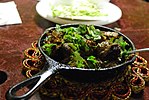
Back مطبخ باكستاني Arabic Пакістанская кухня Byelorussian Пакистанска кухня Bulgarian পাকিস্তানি রন্ধনশৈলী Bengali/Bangla Pákistánská kuchyně Czech Pakistanische Küche German Gastronomía de Pakistán Spanish آشپزی پاکستانی Persian Cuisine pakistanaise French पाकिस्तानी खाना Hindi
This article needs additional citations for verification. (November 2011) |
 |
| This article is part of the series |
| Pakistani cuisine پاکستانی پکوان |
|---|

| Part of a series on the |
| Culture of Pakistan |
|---|
 |
| Traditions |
| folklore |
| Sport |
Pakistani cuisine (Urdu: پاکستانی پکوان, romanized: pākistānī pakwān) is a blend of regional cooking styles and flavours from across South, Central and West Asia. It is a culmination of Iranic, Indic & Arab culinary traditions. The cuisine of Pakistan also maintains certain Mughal influences within its recipes and cooking techniques, particularly the use of dried fruits and nuts.[1][2] Pakistan's ethnic and cultural diversity, diverse climates, geographical environments, and availability of different produce lead to diverse regional cuisines.
Pakistani cuisine, like the culinary traditions of most Muslim-majority nations, adheres to halal principles in accordance with Islamic dietary laws, which prohibit the consumption of pork and alcohol, among other restrictions. Additionally, halal regulations outline specific guidelines for meat consumption, including which animals are considered permissible (halal) and the proper methods of slaughter and preparation to ensure compliance with Islamic dietary practices.
Pakistani cuisine is traditionally centered around meat-based dishes. However, the high cost of meat, coupled with widespread poverty,[3] leads many households to substitute meat for more affordable staples such as lentils, rice, and vegetables.
International cuisine and fast food are popular in major cities such as Islamabad,[4] Lahore[5], Peshawar[6], Quetta[7], and Karachi[8], where local and foreign recipes often merge to create fusion dishes, such as Pakistani-Chinese cuisine. Additionally, as a result of lifestyle changes, health trends, and new dietary research being published, traditional ingredients such as masala (pre-mixed and ready-to-use) and ghee (clarified butter)—with its health benefits and high smoke point—have been increasingly popular.
Similar to other Central Asian cultures, families in Pakistan traditionally dine seated on a dastarkhān—a special rug spread out on the floor. To prevent food spills from soiling the rug, it is typically covered with a plastic sheet or disposable mat. After the meal, tea is customarily served, and family members engage in conversations, relaxing against the large cushions or pillows commonly arranged around the dastarkhān for added comfort.
- ^ Taus-Bolstad, S (2003), Pakistan in Pictures. Lerner Publishing Group. ISBN 978-0-8225-4682-5
- ^ Jonathan H. X. Lee, Kathleen M. Nadeau Encyclopedia of Asian American Folklore and Folklife, Volume 1 page 973 ABC-CLIO, 2011 ISBN 0313350663, 9780313350665
- ^ WorldBank. "World Bank Group - International Development, Poverty and Sustainability". www.worldbank.org. Retrieved 17 January 2025.
- ^ Arshad, Nabiha (24 October 2023). "Top 15 Fast Food Restaurants in Islamabad". Menu Point. Retrieved 15 January 2024.
- ^ Point, Menu (27 October 2023). "Top 15 Fast Food Restaurants in Lahore". Menu Point. Retrieved 13 January 2025.
- ^ "THE 10 BEST Restaurants in Peshawar (Updated August 2024)". Tripadvisor. Archived from the original on 24 August 2024. Retrieved 13 January 2025.
- ^ "THE 10 BEST Restaurants in Quetta - Updated December 2022 - Tripadvisor". www.tripadvisor.com. Archived from the original on 31 December 2022. Retrieved 13 January 2025.
- ^ "Top 15 Fast Food Restaurants in Karachi". Menu Point. 28 October 2023. Retrieved 15 January 2024.